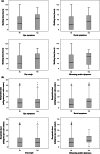The ordinary work environment increases symptoms from eyes and airways in mild steel welders
- PMID: 25744592
- PMCID: PMC4608979
- DOI: 10.1007/s00420-015-1041-2
The ordinary work environment increases symptoms from eyes and airways in mild steel welders
Abstract
Purpose: We aimed to follow diary-registered symptoms from eyes and airways in mild steel welders and relate them to different exposure measures. Furthermore, we would clarify the influence of possible effect modifiers.
Methods: Non-smoking welders with (N = 74) and without (N = 32) work-related symptoms the last month were enroled. Symptoms and work tasks each day for three two-week periods during 1 year were obtained. Respirable dust (RD) was measured 1 day each period for each worker. The personal daily exposure was assessed as: (1) days at work, (2) welding time and (3) estimates of RD from welding and grinding, calculated from diary entries and measurements.
Results: Only 9.2 % of the particle measurements exceed the Swedish occupational exposure limit (OEL; 5 mg/m(3)). Days at work increased the risk of symptoms studied: eyes: 1.79 (1.46-2.19), nasal: 2.16 (1.81-2.58), dry cough: 1.50 (1.23-1.82) and wheezing and/or dyspnoea: 1.27 (1.03-1.56; odds ratio, 95 % confidence interval). No clear dose-response relationships were found for the other exposure estimates. Eye symptoms increased by number of years welding. Nasal symptoms and dry cough increased having forced expiratory volume in first second below median at baseline. Wheezing and/or dyspnoea increased in winter, by number of years welding, having a negative standard skin-prick test and having a vital capacity above median at baseline.
Conclusion: The current Swedish OEL may not protect welders against eye and airway symptoms. The results add to the evidence that welders should be offered regular medical surveillance from early in the career.
Keywords: Diary study; Medical surveillance; Risk factors; Work-related symptoms.
Figures

Similar articles
-
Acute respiratory effects and biomarkers of inflammation due to welding-derived nanoparticle aggregates.Int Arch Occup Environ Health. 2017 Jul;90(5):451-463. doi: 10.1007/s00420-017-1209-z. Epub 2017 Mar 3. Int Arch Occup Environ Health. 2017. PMID: 28258373 Free PMC article.
-
Exposure to respirable dust and manganese and prevalence of airways symptoms, among Swedish mild steel welders in the manufacturing industry.Int Arch Occup Environ Health. 2014 Aug;87(6):623-34. doi: 10.1007/s00420-013-0896-3. Epub 2013 Aug 25. Int Arch Occup Environ Health. 2014. PMID: 23979145
-
[Assessment of occupational exposure of welders based on determination of fumes and their components produced during stainless steel welding].Med Pr. 2011;62(4):359-68. Med Pr. 2011. PMID: 21995105 Polish.
-
Pulmonary fibrosis and exposure to steel welding fume.Occup Med (Lond). 2015 Dec;65(9):706-12. doi: 10.1093/occmed/kqv093. Epub 2015 Jul 7. Occup Med (Lond). 2015. PMID: 26152561 Review.
-
Health effects of welding.Crit Rev Toxicol. 2003;33(1):61-103. doi: 10.1080/713611032. Crit Rev Toxicol. 2003. PMID: 12585507 Review.
Cited by
-
Comprehensive proteome analysis of nasal lavage samples after controlled exposure to welding nanoparticles shows an induced acute phase and a nuclear receptor, LXR/RXR, activation that influence the status of the extracellular matrix.Clin Proteomics. 2018 May 11;15:20. doi: 10.1186/s12014-018-9196-y. eCollection 2018. Clin Proteomics. 2018. PMID: 29760600 Free PMC article.
-
Welding Fumes, a Risk Factor for Lung Diseases.Int J Environ Res Public Health. 2020 Apr 8;17(7):2552. doi: 10.3390/ijerph17072552. Int J Environ Res Public Health. 2020. PMID: 32276440 Free PMC article.
-
Acute respiratory effects and biomarkers of inflammation due to welding-derived nanoparticle aggregates.Int Arch Occup Environ Health. 2017 Jul;90(5):451-463. doi: 10.1007/s00420-017-1209-z. Epub 2017 Mar 3. Int Arch Occup Environ Health. 2017. PMID: 28258373 Free PMC article.
References
-
- Brand P, Gube M, Gerards K, Bertram J, Kaminski H, John AC, Kuhlbusch T, Wiemann M, Eisenbeis C, Winkler R, Kraus T. Internal exposure, effect monitoring, and lung function in welders after acute short-term exposure to welding fumes from different welding processes. J Occup Environ Med. 2010;52:887–892. doi: 10.1097/JOM.0b013e3181f09077. - DOI - PubMed
Publication types
MeSH terms
Substances
LinkOut - more resources
Full Text Sources
Other Literature Sources
Medical
Miscellaneous

